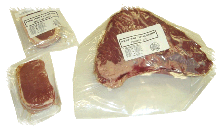
|
Dry Aging The result of dry aging are a steak that is bolder, more tender, with a buttery succulence Up to 20% of the original weight of the loin is lost during the dry aging process. This is why dry aged steak is offered only in fine restaurants, upscale grocery stores and gourmet steak companies. During the dry aging process, the juices are absorbed into the meat, enhancing the flavor and tenderizing the steaks. Research from major universities, indicates the enhancement of flavor and tenderness occurs in this Dry Aging process. Dry Aged Steaks are very popular in the fine, white linen steakhouses on the coasts. Dry Aged Beef: After harvest, the carcass of your animal is dry aged for about 17 days to insure the correct flavor and tenderness. Dry aging produces the "nutty" flavor which distinguishes it from beef exposed to wet aging which takes place in a plastic bag. Wet aging is used by most commercial packing companies - it is more efficient and cheaper for the packing house. Dry aging allows the meat to be tenderized by natural enzymes within the meat itself. Premium beef offerings, in upscale restaurants and gourmet food stores are dry aged. Of course, all of the beef in our beef purchase plan , including the ground beef, is dry aged. Each year one of our repeat customers sends us a note about the beef. Dry aging is the type of aging that your grandparents and parents may have talked about because it brings out that great beef taste while allowing for tenderization to occur! Two of our customers have commented that the flavor of the beef they received from their share in Sell Farm cattle reminded them of the meat they ate when they were children. Dry aging reduces moisture in the meat and therefore concentrates the flavor- it may also reduce the weight of the carcass up to 20%. This means you receive fewer pounds. The meat does not taste dry, or feel dry to the palate because the decrease in moisture is imperceptible. Dry aging is a time consuming process, and it is expensive, but we think it is worth the time, effort and added cost to achieve the difference in taste. Does freezing a steak affect the taste? Aging also increases tenderness. It has been shown that during the aging process certain changes take place in portions of the structure of collagen and muscle fibers. Currently, it is thought that enzymatic-caused changes in the structure of muscle fibers are largely responsible for the increase in tenderness.
|
||||||||||||||||
|
|||||||||||||||||||||

